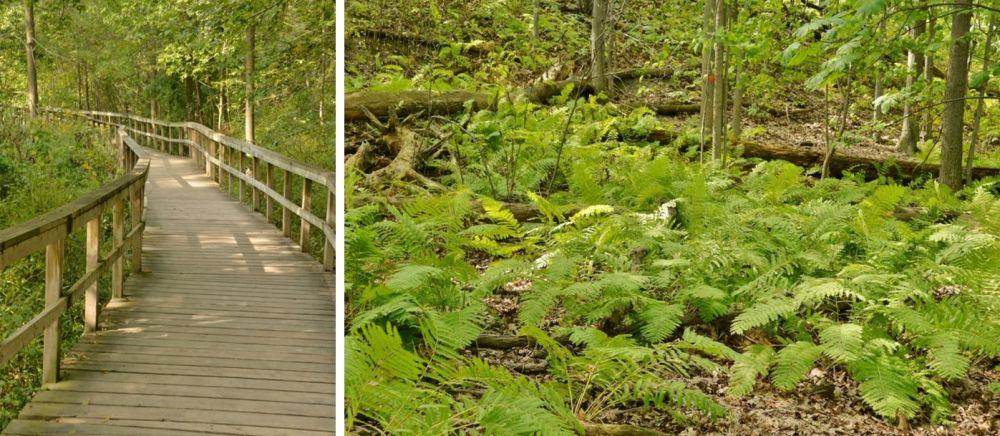The meeting point for the tour was the open lawn in Jack Daniels Memorial Park (JDMP) on the Lake Ontario shoreline with a spectacular view the distant Toronto skyline. Philip van Wassenaer (Urban Forest Innovations), the tour guide, took us along the first stretch of the boardwalk to a map of Rattray Marsh Conservation Area and outlined the geography. Along the way he answered questions in a one-on-one tutorial. We passed The Knoll, a hill about thirty feet high with different vegetation than the surrounding area. We came to a slope open to the sky, at the foot of which lay large ash trunks felled in exes and triangles. Ash trees like a wetter environment, so there are a large number found in the area bordering the marsh. Most were affected by the emerald ash borer (EAB). Dead ash trees rot at the junction of trunk with soil and will topple unpredictably, making them hazardous to the passerby. Those trees designated for cutting were marked with a dayglow orange slash on one side of the trunk.

Higher up the slope, invasive Manitoba maples had been purposely girdled in an effort to kill them. A sign on one girdled tree explained the strategy – Manitoba maples create a dense shade and a rain of seedlings that prevent native species from becoming established. Opening the area should let native pioneer species like birch and poplar take hold.
Our next stop was the planting site of One Million Trees Mississauga where ash trees had been felled flush with the soil. Out of the roots had arisen suckering growth, lush green and bush-like. As Philip pointed out, EAB still lurked in these resurgences and they were not healthy replacements. On both sides of the path was a carpet of wood chips, ash trees ground up finely enough to kill all of the EAB insects in the wood. On two chest-high sections of a split rail fence built from debarked ash Philip pointed out the hieroglyphic-like markings of EAB on the dead wood. They resembled a low relief etching from a mysterious Inca or Aztec civilisation, surprisingly intricate.

As we traversed the extensive boardwalk across the marsh we passed a sign warning of Asian carp (an invasive fish species). The tour then returned to The Knoll where Philip pointed out the slow growing, long lived red oak (250 years) and white oak (500 years) overhanging Sheridan Creek and how to differentiate one from the other. A full sized birch was being crowded out by neighbouring trees - forest succession in action. Fallen trunks and a white pine were being rendered fertilizer. A mid-sized beech trunk showed small fissures, signs of beech bark disease, a mixed scale fungus infection introduced from Europe. The sunlit west side of The Knoll presented different undergrowth than the more shaded east, which was carpeted in ferns.

Through a series of living examples, Philip had provided cogent demonstrations of the importance of forest diversity, the risk invasive species, and human intervention with knowledge and insight into improved forest management. I thought that the location of the tour was superb, the diversity of environments unsurpassed and the insights well crafted. With so much on offer, I would go back to the confluence of these two parks in a heartbeat.
David Slaughter is a LEAF volunteer and amateur photographer who focuses on nature photography in all forms, particularly flowers and flowering trees. He was the volunteer photographer on the tree tour that followed this event.
LEAF’s Tree Tours in Mississauga are supported by the City of Mississauga.
